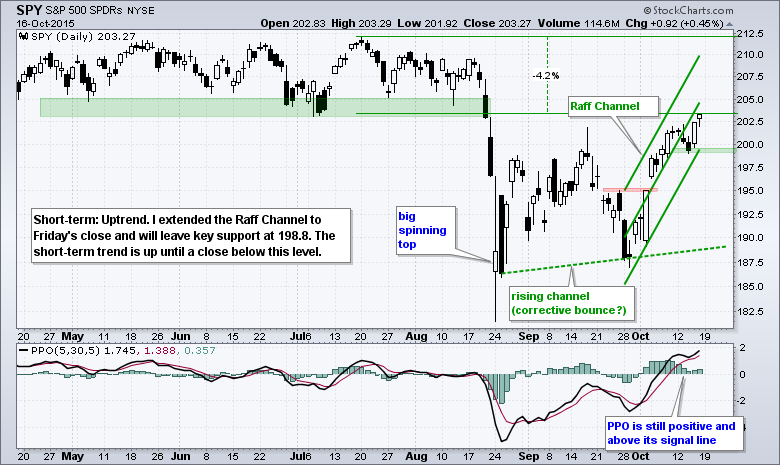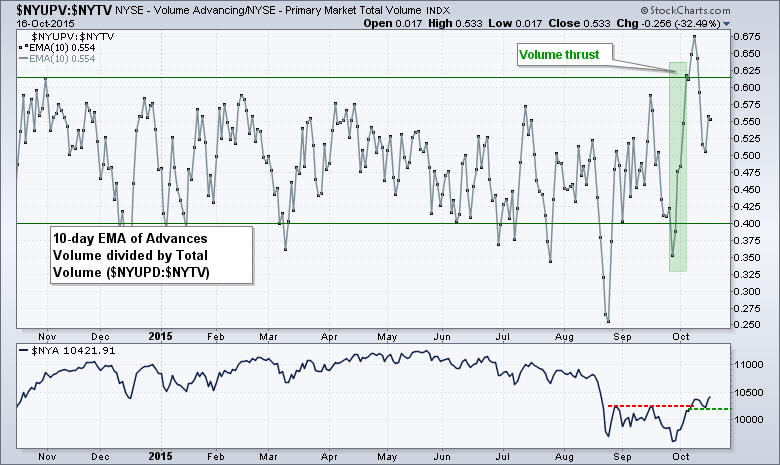I am starting to entertain the idea that the surge from late September to mid October was strong enough to negate the August breakdowns in SPY and QQQ. The bounce over the last few weeks contained strong breadth and strong upside volume. Also notice that SPY broke above the mid September high and is less than 5% from its all time high. QQQ did not exceed the intraday high in mid September, but did close above the mid September closing high and is less than 6% from its all time high. Overall, SPY and QQQ have uptrends working since late August with higher lows in late September and higher highs in mid October.
The zigzag advances since late August could be a mere corrective bounce within a bigger downtrend, but we have yet to see even a short-term trend reversal. QQQ and SPY hit new highs for the short-term advance and I extended the Raff Regression Channels. We cannot entertain thoughts of a bigger downtrend as long as these short-term trends are up. At the very least, QQQ and SPY need to close below last week's lows to reverse these short-term uptrends. Then, and only, then, will I return to thoughts of a bigger downtrend.
The Russell 2000 iShares (IWM) remains the outlier here because it has yet to exceed its mid September high and continues to show relative weakness. The ETF broke support at 114 on Wednesday, but immediately surged back above the support break and closed above 115 on Thursday. At this point, I think IWM is hostage to the price action in SPY and QQQ because the latter two have well defined uptrends and support levels. Short-term reversals in SPY and QQQ would be bearish for IWM.
Can we Ignore Breadth Thrust and Volume Thrust?
The bigger picture for large-caps is looking more bullish because of the breadth thrust and volume thrust. First, we had the Zweig breadth thrust on October 8th. This is when the 10-day EMA of NYSE Advances divided by the sum of Advances plus Declines surges from .40 to .615 within 10 trading days. In the indicator window the NY Composite broke above its mid September high and is still holding this breakout. A close below 10200 would put the index back below the breakout and call for a re-evaluation.
In addition to the breadth thrust, we also saw a similar volume thrust in early October. The chart below shows a 10-day EMA of NYSE Advancing Volume divided by NYSE Total Volume, which makes it a close cousin to the Zweig breadth thrust. This indicator also surged from below .40 to above .615 within a 10-day period.
Note that there are different ways to measure such a thrust. Bill Shelby noted in the Saturday webinar, that NYSE Advancing volume surged over the last few weeks. Bill's part starts around the 48 minute mark. James Stack of InvesTech was quoted in Barron's and noted strong action in the AD Volume Ratio. Stack called the October surge "no ordinary rebound" and backed his assessment with historical figures.
Even though small-caps are lagging and SPY remains below its August support break, the breadth and volume thrusts are enough to at least turn neutral on the long-term trend. Short-term, I would not be surprised to see choppy trading continue because of the mixed message from the stock market. Large-caps are leading, but small-caps are lagging. SPY and QQQ formed higher lows in September, but IWM and IJR formed lower lows. SPY is above the September high, but IWM is below the September high. Clearly, small-caps are not on the same page as large-caps and this could hinder broad market performance. Also note that the Equal-Weight Consumer Discretionary ETF (RCD) is underperforming the Consumer Discretionary SPDR (XLY) . It's still a large-cap world out there.
****************************************
Thanks for tuning in and have a good day!
--Arthur Hill CMT
Plan your Trade and Trade your Plan
****************************************




